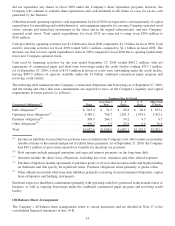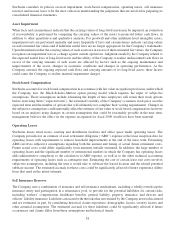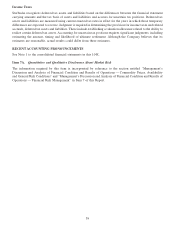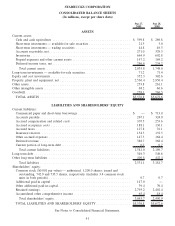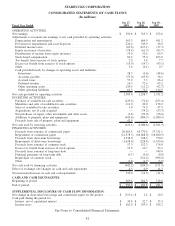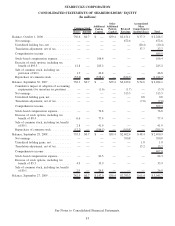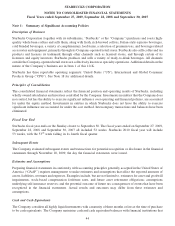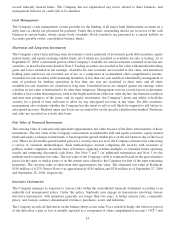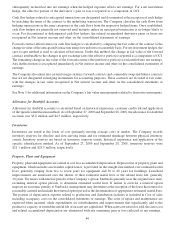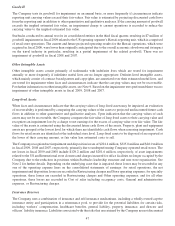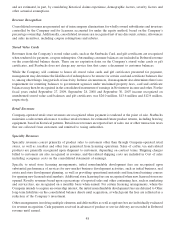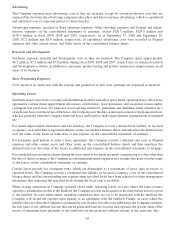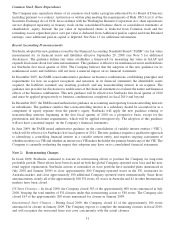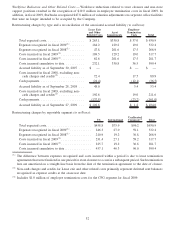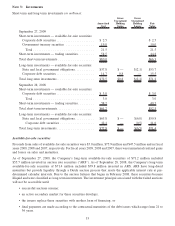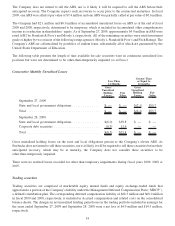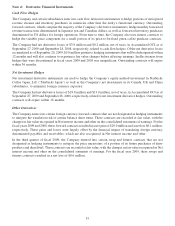Starbucks 2009 Annual Report Download - page 53
Download and view the complete annual report
Please find page 53 of the 2009 Starbucks annual report below. You can navigate through the pages in the report by either clicking on the pages listed below, or by using the keyword search tool below to find specific information within the annual report.exceed federally insured limits. The Company has not experienced any losses related to these balances, and
management believes its credit risk to be minimal.
Cash Management
The Company’s cash management system provides for the funding of all major bank disbursement accounts on a
daily basis as checks are presented for payment. Under this system, outstanding checks are in excess of the cash
balances at certain banks, which creates book overdrafts. Book overdrafts are presented as a current liability in
Accounts payable on the consolidated balance sheets.
Short-term and Long-term Investments
The Company’s short-term and long-term investments consist primarily of investment grade debt securities, equity
mutual funds, and equity exchange-traded funds, all of which are classified as available-for-sale or trading. As of
September 27, 2009, a substantial portion of the Company’s available-for-sale investments consisted of auction rate
securities, as described in more detail in Note 3. Trading securities are recorded at fair value withunrealized holding
gains and losses included in net earnings. Available-for-sale securities are recorded at fair value, and unrealized
holding gains and losses are recorded, net of tax, as a component of accumulated other comprehensive income.
Available-for-sale securities with remaining maturities of less than one year and those identified by management at
time of purchase for funding operations in less than one year are classified as short term, and all other
available-for-sale securities are classified as long term. Unrealized losses are charged against net earnings when
a decline in fair value is determined to be other than temporary. Management reviews several factors to determine
whether a loss is other than temporary, such as the length and extent of the fair value decline, the financial condition
and near term prospects of the issuer, and for equity investments, the Company’s intent and ability to hold the
security for a period of time sufficient to allow for any anticipated recovery in fair value. For debt securities,
management also evaluates whether the Company has the intent to sell or will likely be required to sell before its
anticipated recovery. Realized gains and losses are accounted for on the specific identification method. Purchases
and sales are recorded on a trade date basis.
Fair Value of Financial Instruments
The carrying value of cash and cash equivalents approximates fair value because of the short-term maturity of those
instruments. The fair value of the Company’s investments in marketable debt and equity securities, equity mutual
funds and equity exchange-traded funds, is based upon the quoted market price on the last business day of the fiscal
year. Where an observable quoted market price for a security does not exist, the Company estimates fair value using
a variety of valuation methodologies. Such methodologies include comparing the security with securities of
publicly traded companies in similar lines of business, applying revenue multiples to estimated future operating
results and estimating discounted cash flows. See Note 3 and 7 for additional information and Note 5 for the
methods used to measure fair value. The fair value of the Company’s debt is estimated based on the quoted market
prices for the same or similar issues or on the current rates offered to the Company for debt of the same remaining
maturities. The carrying value of short-term debt approximates fair value. The estimated fair value of Starbucks
$550 million of 6.25% Senior Notes was approximately $591 million and $536 million as of September 27, 2009
and September 28, 2008, respectively.
Derivative Instruments
The Company manages its exposure to various risks within the consolidated financial statements according to an
umbrella risk management policy. Under this policy, Starbucks may engage in transactions involving various
derivative instruments, with maturities generally not longer than five years, to hedge interest rates, commodity
prices, and foreign currency denominated revenues, purchases, assets and liabilities.
The Company records all derivatives on the balance sheets at fair value. For a cash flow hedge, the effective portion
of the derivative’s gain or loss is initially reported as a component of other comprehensive income (“OCI”) and
45


